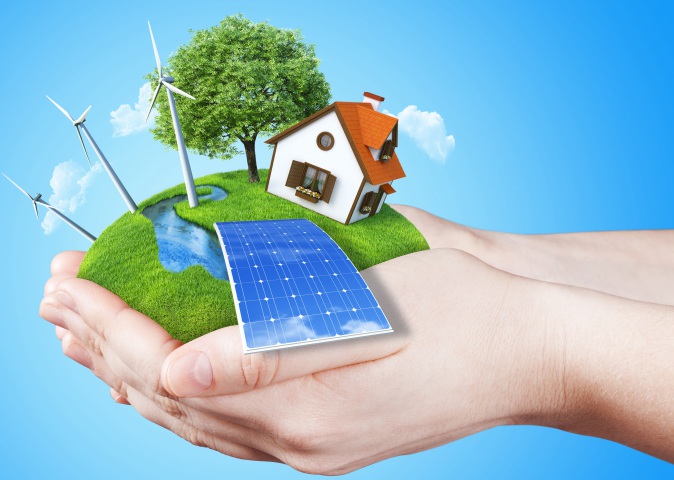
Les plastiques se font une place au soleil
Silicon? Not so green!
Not so long ago, solar panels were touted as being the high-tech solution to all of our energy problems - cost of raw materials of fossil origin, pollution, carbon footprint, etc. It only took a few years to realize that this was not necessarily true. Silicon-based solar panels are expensive, and their performance isn't up to much in relatively overcast countries such as those in northern Europe. What's more, a closer analysis of their life cycle reveals that they aren't quite as environmentally friendly as had been promised. "Manufacturing" silicon requires tons of sand to be heated to over one thousand degrees...which is a phenomenal amount of energy to expend. As a result, the solar panel market is in a slump and many of the industry's companies are throwing in the towel. However, there is cause for optimism. Although solar panels made of glass are a thing of the past, a new generation is on its way. Panels made of plastic!

A matter of performance
 A typical solar panel, made from silicon, has an average efficiency of 15%. Efficiency, of course, is the conversion rate of sunlight into energy. Not very impressive to say the least. That achieved with plastic is not much better. But that's about to change. According to leading plastics manufacturers, new technologies and the new polymers currently in development should achieve close to 40% efficiency within a few years. And this is no empty promise, given that until recently the best plastics-based photovoltaic cells were barely achieving 10% efficiency. This type of progress is thanks to combinations of new polymers, some of which come straight from recent research.
A typical solar panel, made from silicon, has an average efficiency of 15%. Efficiency, of course, is the conversion rate of sunlight into energy. Not very impressive to say the least. That achieved with plastic is not much better. But that's about to change. According to leading plastics manufacturers, new technologies and the new polymers currently in development should achieve close to 40% efficiency within a few years. And this is no empty promise, given that until recently the best plastics-based photovoltaic cells were barely achieving 10% efficiency. This type of progress is thanks to combinations of new polymers, some of which come straight from recent research.
A wealth of new materials
 Polyvinylidene fluoride, ethylene-vinyl acetate copolymer, organic peroxides ... Don't worry, we won't go on even though there are many more items on the list of arcanely-named polymers. These latest generation plastics are a cornerstone of future solar panels. Their technical characteristics guarantee not only perfect cell insulation but also, and above all, optimum concentration of sunlight to deliver the best possible performance. And like many plastics, they are simple and inexpensive to produce. Finally, manufacturers are now carefully studying the plastics' life cycles and ensuring that a large majority of the components are recyclable.
Polyvinylidene fluoride, ethylene-vinyl acetate copolymer, organic peroxides ... Don't worry, we won't go on even though there are many more items on the list of arcanely-named polymers. These latest generation plastics are a cornerstone of future solar panels. Their technical characteristics guarantee not only perfect cell insulation but also, and above all, optimum concentration of sunlight to deliver the best possible performance. And like many plastics, they are simple and inexpensive to produce. Finally, manufacturers are now carefully studying the plastics' life cycles and ensuring that a large majority of the components are recyclable.
Self-adhesive panels
Some research centres are going even further. A group of researchers at Belo Horizonte, in Brazil, have met the challenge of developing plastic solar panels which are less than 1mm in thickness. While the technology already exists to recharge mobile phone batteries, for instance, this Brazilian team developed real solar panels, capable of producing enough electricity to power a refrigerator, lamp and TV. Besides its ease of application and being flexible enough to marry the most convoluted forms, this technology has another major advantage: increased cell performance with rising temperatures. Quite the opposite of silicon panels whose efficiency decreases as temperatures rise.

Solar film on Hong Kong roofs
 Cette nouvelle génération de panneaux solaires souples et facilement applicables intéresse au plus haut point les autorités de Hong Kong qui envisagent d’en poser des centaines de mètres carrés sur les toits de l’emblématique cité. Associées à Dupont, elles espèrent ainsi fournir en électricité plus de 150 logements et bureaux par immeuble. Avantage de cette technologie, les panneaux ont un rendement maximal lorsque le soleil est au plus chaud, c’est-à-dire durant les heures de bureau. Ce serait aussi plus de 500 t de dioxyde de carbone par an qui pourraient ne pas se retrouver dans l’atmosphère.
Cette nouvelle génération de panneaux solaires souples et facilement applicables intéresse au plus haut point les autorités de Hong Kong qui envisagent d’en poser des centaines de mètres carrés sur les toits de l’emblématique cité. Associées à Dupont, elles espèrent ainsi fournir en électricité plus de 150 logements et bureaux par immeuble. Avantage de cette technologie, les panneaux ont un rendement maximal lorsque le soleil est au plus chaud, c’est-à-dire durant les heures de bureau. Ce serait aussi plus de 500 t de dioxyde de carbone par an qui pourraient ne pas se retrouver dans l’atmosphère.





